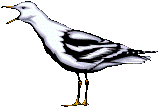Eastern Wildlife Damage Control Conferences

Eastern Wildlife Damage Control Conference: 2nd (1985)
Date of this Version
September 1985
Document Type
Article
Abstract
In recent years, non-migratory flocks of Canada Geese have become established in some urban and suburban areas. These birds often become a serious nuisance when they litter backyards, parks and beaches with fecal material, creating a potential health hazard especially for young children. To determine the scope of the problem, I surveyed golf course managers in the eastern U.S. to see if they were experiencing a problem with geese. This survey showed that this problem was widespread, occurring throughout the eastern U.S., and appeared to be increasing. Twenty-six percent of all respondents reported nuisance goose problems and were willing to spend an average of $444/year to be rid of the geese. Unfortunately, there are no good solutions to these problems. Since geese enter these areas to feed on the turf, however, one possibility is to use the chemical repellent, methiocarb, to keep geese out of sites where they are unwanted. To explore this possibility, I noted the response of Canada Geese to methiocarb-treated grass. When 0.5 ha plots on golf courses were treated with methiocarb, free-ranging geese avoided these plots for 1-2 weeks. When entire feeding sites were treated, geese avoided these areas for up to 10 weeks. These results indicate that a methiocarb-induced aversive conditioning program may be effective in alleviating some nuisance goose problems. Another potential solution is to try to discourage geese from nuisance sites by planting those sites with some type of grass or cover that geese do not like to eat. I tested this by giving captive geese the opportunity to feed on plots of Kentucky bluegrass, colonial bentgrass, perennial ryegrass, red fescue, and tall fescue. When given a choice, the geese fed significantly more on Kentucky bluegrass and significantly less on tall fescue than any of the other grasses. Hungry geese however, grazed on any of the grasses if no choice was provided. Hence, discouraging geese from problem sites by planting these areas in a fescue may work, but only if there are good alternative sites available to the geese. Even more effective would be to replace the grass with another type of ground cover, such as Pachysandra or English ivy, which geese find unpalatable.

